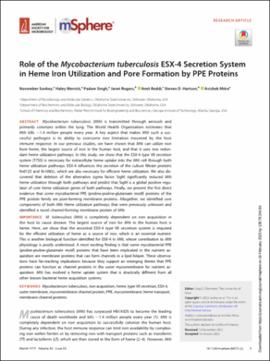| dc.contributor.author | Sankey, November | |
| dc.contributor.author | Merrick, Haley | |
| dc.contributor.author | Singh, Padam | |
| dc.contributor.author | Rogers, Janet | |
| dc.contributor.author | Reddi, Amit | |
| dc.contributor.author | Hartson, Steven D. | |
| dc.contributor.author | Mitra, Avishek | |
| dc.contributor.editor | Ellermeier, Craig D | |
| dc.date.accessioned | 2023-02-16T16:35:33Z | |
| dc.date.available | 2023-02-16T16:35:33Z | |
| dc.date.issued | 2023-02-07 | |
| dc.identifier.citation | Sankey, N., Merrick, H., Singh, P., Rogers, J., Reddi, A., Hartson, S. D., Mitra, A. (2023). Role of the Mycobacterium tuberculosis ESX-4 Secretion System in Heme Iron Utilization and Pore Formation by PPE Proteins. mSphere, pp. e00573-e00522. https://doi.org/10.1128/msphere.00573-22 | |
| dc.identifier.issn | 1556-6811 | |
| dc.identifier.uri | https://hdl.handle.net/11244/337035 | |
| dc.description.abstract | Mycobacterium tuberculosis (Mtb) is transmitted through aerosols and primarily colonizes within the lung. The World Health Organization estimates that Mtb kills ~1.4 million people every year. A key aspect that makes Mtb such a successful pathogen is its ability to overcome iron limitation mounted by the host immune response. In our previous studies, we have shown that Mtb can utilize iron from heme, the largest source of iron in the human host, and that it uses two redundant heme utilization pathways. In this study, we show that the ESX-4 type VII secretion system (T7SS) is necessary for extracellular heme uptake into the Mtb cell through both heme utilization pathways. ESX-4 influences the secretion of the culture filtrate proteins Rv0125 and Rv1085c, which are also necessary for efficient heme utilization. We also discovered that deletion of the alternative sigma factor SigM significantly reduced Mtb heme utilization through both pathways and predict that SigM is a global positive regulator of core heme utilization genes of both pathways. Finally, we present the first direct evidence that some mycobacterial PPE (proline-proline-glutamate motif) proteins of the PPE protein family are pore-forming membrane proteins. Altogether, we identified core components of both Mtb Heme utilization pathways that were previously unknown and identified a novel channel-forming membrane protein of Mtb. IMPORTANCE M. tuberculosis (Mtb) is completely dependent on iron acquisition in the host to cause disease. The largest source of iron for Mtb in the human host is heme. Here, we show that the ancestral ESX-4 type VII secretion system is required for the efficient utilization of heme as a source of iron, which is an essential nutrient. This is another biological function identified for ESX-4 in Mtb, whose contribution to Mtb physiology is poorly understood. A most exciting finding is that some mycobacterial PPE (proline-proline-glutamate motif) proteins that have been implicated in the nutrient acquisition are membrane proteins that can form channels in a lipid bilayer. These observations have far-reaching implications because they support an emerging theme that PPE proteins can function as channel proteins in the outer mycomembrane for nutrient acquisition. Mtb has evolved a heme uptake system that is drastically different from all other known bacterial heme acquisition systems. | |
| dc.format | application/pdf | |
| dc.language | eng | |
| dc.publisher | American Society for Microbiology | |
| dc.relation.ispartof | mSphere | |
| dc.relation.uri | https://www.ncbi.nlm.nih.gov/pubmed/36749044 | |
| dc.relation.uri | http://dx.doi.org/10.1128/msphere.00573-22 | |
| dc.rights | This material has been previously published. In the Oklahoma State University Library's institutional repository this version is made available through the open access principles and the terms of agreement/consent between the author(s) and the publisher. The permission policy on the use, reproduction or distribution of the material falls under fair use for educational, scholarship, and research purposes. Contact Digital Resources and Discovery Services at lib-dls@okstate.edu or 405-744-9161 for further information. | |
| dc.title | Role of the Mycobacterium tuberculosis ESX-4 secretion system in heme iron utilization and pore formation by PPE proteins | |
| dc.date.updated | 2023-02-15T22:53:17Z | |
| dc.note | open access status: Closed Access | |
| dc.identifier.doi | 10.1128/msphere.00573-22 | |
| dc.description.department | Microbiology and Molecular Genetics | |
| dc.type.genre | Article | |
| dc.type.material | Text | |
| dc.subject.keywords | Tuberculosis | |
| dc.subject.keywords | Infectious Diseases | |
| dc.subject.keywords | Rare Diseases | |
| dc.subject.keywords | Prevention | |
| dc.subject.keywords | Orphan Drug | |
| dc.subject.keywords | Aetiology | |
| dc.subject.keywords | Biological and endogenous factors | |
| dc.subject.keywords | Factors relating to the physical environment | |
| dc.subject.keywords | Infection | |
| dc.subject.keywords | Good Health and Well Being | |
| dc.subject.keywords | ESX- | |
| dc.subject.keywords | Mycobacterium tuberculosis | |
| dc.subject.keywords | PPE | |
| dc.subject.keywords | heme | |
| dc.subject.keywords | heme transport | |
| dc.subject.keywords | iron acquisition | |
| dc.subject.keywords | type VII secretion | |
| dc.subject.keywords | Immunology | |
| dc.subject.keywords | Microbiology | |
| dc.subject.keywords | membrane channel proteins | |
| dc.subject.keywords | mycomembrane | |
| dc.subject.keywords | mycomembrane channel protein | |
| dc.subject.keywords | outer membrane | |
| dc.relation.oaurl | https://pubmed.ncbi.nlm.nih.gov/36749044/ | |
| dc.identifier.author | ORCID: 0000-0003-0243-2045 (Mitra, Avishek) | |
| dc.identifier.essn | 2379-5042 | |
